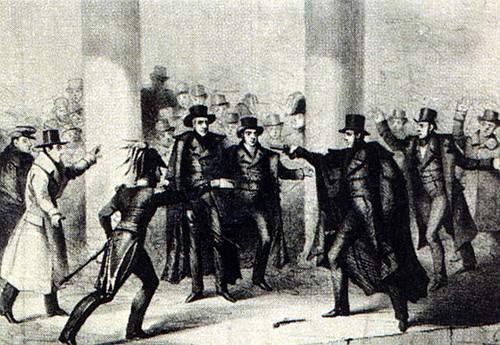
On Jan. 30, 1835, as Andrew Jackson was departing a U.S. representative’s funeral service at the Capitol, troubled English house painter Richard Lawrence confronted him, drew a pistol from his pocket, pointed it at Jackson’s heart, and pulled the trigger.
“The explosion of the cap was so loud that many persons thought the pistol had fired,” said Sen. Thomas Benton, who heard it from the foot of the steps. It hadn’t — only the cap had exploded.
Realizing the misfire, Lawrence dropped the pistol and drew another of the same make and design from his pocket. He cocked it, aimed it at Jackson’s heart, and pulled the trigger. A second shot reverberated through the rotunda, but again only the cap had exploded. The crowd subdued Lawrence, who was later found to be insane.
The sergeant-at-arms at the Capitol recovered both pistols and found that they had been properly loaded. Meriwether Lewis Randolph found that they had contained “powder of the best quality, & the balls rammed tight,” but “the percussion caps exploded without igniting the powder.” Jack Donelson recapped the pistols and tested them to see if they would fire, and they did, perfectly.
An expert on small arms estimated the odds of two successive misfires of perfectly loaded pistols with high-quality powder at about 125,000 to 1. Benton wrote, “The circumstance made a deep impression upon the public feeling and irresistibly carried many mind to the belief in a superintending Providence, manifested in the extraordinary case of two pistols in succession — so well loaded, so coolly handled, and which afterwards fired with such readiness, force, and precision — missing fire, each in its turn, when leveled eight feet at the President’s heart.”
